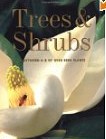 Trees and shrubs are the backbone of most gardens and a familiarity with the huge diversity of plants available is an asset to any gardener. There are many books written about trees and shrubs but I have never encountered one as comprehensive as this one. It provides information on selecting and growing over 8,500 plants from around the world with a multitude of pictures to illustrate the unique characteristics of plants.
Trees and shrubs are the backbone of most gardens and a familiarity with the huge diversity of plants available is an asset to any gardener. There are many books written about trees and shrubs but I have never encountered one as comprehensive as this one. It provides information on selecting and growing over 8,500 plants from around the world with a multitude of pictures to illustrate the unique characteristics of plants.
The examples presented in the book were selected from the 150,000 species of trees and shrubs that exist in the world. The selection was made on the basis of the significance of each “to ornamental horticuture, forestry, fruit-growing, and for by-products such as medicines, drugs, fibers, and dyes.” In addition, shrubs and trees are included for other reasons such as their adaption to extreme environments or their unique position in the evolution of the plant kingdom. More plants from temperate zones than tropical zones were selected since the book was written with gardeners living in temperate zones.
The first section of the book provides an overview of shrubs and trees as garden plants. It includes a consideration of climate, habitats, relationship to animals, and landscape uses as well as suitable soils, pruning, and propagation. An introduction to plant classification explains the hierarchy of the system and the significance of hybrids and cultivars, setting the stage for the second and largest section of the book, the encyclopedia of over 8,500 plants organized alphabetically by genus and species.
Beginning with Abelia and ending with Ziziphus (a tropical evergreen), the encyclopedia begins with an entry about the genus taking into account such variables as he geographical range, number of species, distinguishing features, commercial uses, and propagation and cultivation requirements. The entry on the genus is followed by entries on a number of species including synonym, common name, the plant’s size, growth habit, flowering season, flower color, forms, and hardiness zones as applicable. At least one picture labeled with the botanical name is included for most species to show the plant characteristics that make it special. The entry on Leptospermum scoparium, for example, includes nine pictures to show both the nature of the shrub and the differences between the flowers of various cultivars. Very helpful!
The final section of the book provides illustrated guides to leaves, flowers and fruits, a glossary, reference table of plants, and an index of common and botanical names. The illustrated guide to leaves provides a diagram of the basic structures of a leaf and then illustrations of different leaf shapes, arrangements, margins, basis, tips, and compounding. The illustrated guide to flower types presents a labeled diagram of a typical flower and proceeds to elaborate on the shapes and orientation of flowers, as well as the different kinds of inflorescence. The illustrated guide of fruits does the same thing for fruits. No longer does the reader need to puzzle over plant descriptions that include terms such as hastate, corymb or schizocarp. The glossary includes all the illustrated terms and a whole lot more so that reading plant descriptions becomes much easier and more understandable. The reference table of plants includes all the information needed to help a gardener chose an appropriate plant for a particular location while the index helps put common and botanical names together on the right plant.
If you like trees and shrubs this is a GREAT resource. The more I use it the more I love it and depend on it for getting to know new plants. It is a very large and heavy book and so not suitable for taking out in the garden but it is a treasure trove of information and perfect for a reference library.
To buy Trees and Shrubs: A-Z of Over 8500 Plants from Amazon.com click here.